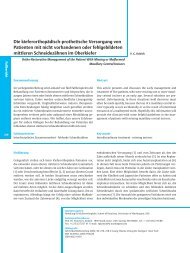altering vertical dimension in the perio-restorative patient - Kokich ...
altering vertical dimension in the perio-restorative patient - Kokich ...
altering vertical dimension in the perio-restorative patient - Kokich ...
Create successful ePaper yourself
Turn your PDF publications into a flip-book with our unique Google optimized e-Paper software.
2 ALTERING VERTICAL DIMENSION IN THE PERIO-RESTORATIVE PATIENT • <strong>Kokich</strong><br />
Case 7: Deep anterior overbite and extremely short<br />
lower facial height<br />
This 59-year-old woman was unhappy with <strong>the</strong> es<strong>the</strong>tic appearance of her smile. Specifically,<br />
she showed very little of her maxillary <strong>in</strong>cisors upon smil<strong>in</strong>g. She had a heavily restored dentition<br />
with a deep anterior overbite of 7 mm (Figs 2-7a to 2-7d).<br />
The first step was to establish <strong>the</strong> occlusal plane between <strong>the</strong> second molars and <strong>the</strong> upper<br />
lip. The maxillary <strong>in</strong>cisal edges were 1 mm above, ra<strong>the</strong>r than 1 mm below, <strong>the</strong> level of <strong>the</strong><br />
occlusal plane. The mandibular <strong>in</strong>cisal edges, which should be at <strong>the</strong> level of <strong>the</strong> occlusal plane,<br />
were 5 mm above it. Intrud<strong>in</strong>g <strong>the</strong> mandibular <strong>in</strong>cisors and extrud<strong>in</strong>g <strong>the</strong> maxillary <strong>in</strong>cisors to<br />
show more of <strong>the</strong> maxillary anterior teeth would be difficult to accomplish orthodontically.<br />
However, <strong>the</strong> <strong>patient</strong>’s facial proportions, ie, her extremely short lower facial height, suggested<br />
that she could benefit from mandibular surgery to rotate <strong>the</strong> mandible downward <strong>in</strong> front<br />
comb<strong>in</strong>ed with maxillary surgery to rotate <strong>the</strong> maxilla downward <strong>in</strong> <strong>the</strong> anterior. Both of <strong>the</strong>se<br />
surgeries could be accomplished without open<strong>in</strong>g <strong>the</strong> posterior <strong>vertical</strong> <strong>dimension</strong> <strong>in</strong> order to<br />
avoid <strong>alter<strong>in</strong>g</strong> muscle length and to enhance stability (Fig 2-7e). The alteration <strong>in</strong> facial proportion<br />
<strong>in</strong> this <strong>patient</strong> after surgery vastly improved <strong>the</strong> es<strong>the</strong>tics of her smile (Figs 2-7f to 2-7h).<br />
IINCREASING THE VERTICAL DIMENSION<br />
ORTHODONTICALLY: BIOLOGIC<br />
CONSIDERATIONS<br />
Plann<strong>in</strong>g <strong>restorative</strong> rehabilitation for a <strong>patient</strong> with a deep anterior overbite and significant maxillary<br />
and mandibular anterior tooth wear is a challeng<strong>in</strong>g and often confus<strong>in</strong>g task for <strong>the</strong> <strong>restorative</strong><br />
dentist. The typical thought process would suggest that <strong>the</strong> <strong>vertical</strong> <strong>dimension</strong> should be<br />
<strong>in</strong>creased by <strong>restorative</strong>ly “open<strong>in</strong>g <strong>the</strong> bite,” <strong>the</strong>reby permitt<strong>in</strong>g space to leng<strong>the</strong>n <strong>the</strong> abraded<br />
teeth. However, if <strong>the</strong> tooth wear is limited to <strong>the</strong> mandibular <strong>in</strong>cisors, <strong>the</strong>n many nonabraded posterior<br />
teeth would have to be restored to open <strong>the</strong> <strong>patient</strong>’s <strong>vertical</strong> <strong>dimension</strong>. In <strong>the</strong>se situations,<br />
<strong>the</strong> <strong>restorative</strong> dentist must realize that when teeth wear as a result of a protrusive brux<strong>in</strong>g habit,<br />
<strong>the</strong>y cont<strong>in</strong>ue to erupt so as to ma<strong>in</strong>ta<strong>in</strong> occlusal contact. As <strong>the</strong>y erupt, <strong>the</strong>y br<strong>in</strong>g <strong>the</strong> g<strong>in</strong>giva and<br />
bone with <strong>the</strong>m. Therefore, <strong>the</strong> most logical method of correct<strong>in</strong>g this problem is to <strong>in</strong>trude <strong>the</strong><br />
abraded teeth so that <strong>the</strong> crowns can be restored to <strong>the</strong>ir orig<strong>in</strong>al length without fur<strong>the</strong>r tooth<br />
preparation. Adjunctive orthodontics is required to accomplish <strong>the</strong> <strong>in</strong>trusion.<br />
In some <strong>patient</strong>s with severe attrition of <strong>the</strong> mandibular anterior teeth, <strong>the</strong>re is <strong>in</strong>sufficient<br />
crown length ei<strong>the</strong>r to place orthodontic brackets or to permit adequate ferrule for tooth<br />
preparation, or both. In <strong>the</strong>se situations, some <strong>perio</strong>dontal surgery and crown leng<strong>the</strong>n<strong>in</strong>g<br />
prior to orthodontic <strong>in</strong>trusion may be appropriate. 4 The key is to carefully assess <strong>the</strong> exist<strong>in</strong>g<br />
crown length of <strong>the</strong> abraded teeth. Is <strong>the</strong>re sufficient <strong>in</strong>terproximal and labiol<strong>in</strong>gual tooth<br />
length to provide a m<strong>in</strong>imum of 1.5 to 2 mm of ferrule? If <strong>the</strong> answer is yes, <strong>the</strong>n orthodontic<br />
<strong>in</strong>trusion can be used to create <strong>the</strong> <strong>in</strong>terocclusal space, and <strong>the</strong> tooth preparation requirements<br />
will be acceptable. 5–10 However, if <strong>the</strong> exist<strong>in</strong>g crown length is <strong>in</strong>sufficient, <strong>the</strong>n crown leng<strong>the</strong>n<strong>in</strong>g<br />
surgery should be performed first to establish adequate ferrule, 11 <strong>the</strong>n <strong>the</strong> teeth should<br />
be <strong>in</strong>truded orthodontically to create <strong>the</strong> correct <strong>vertical</strong> position prior to restoration.<br />
18





